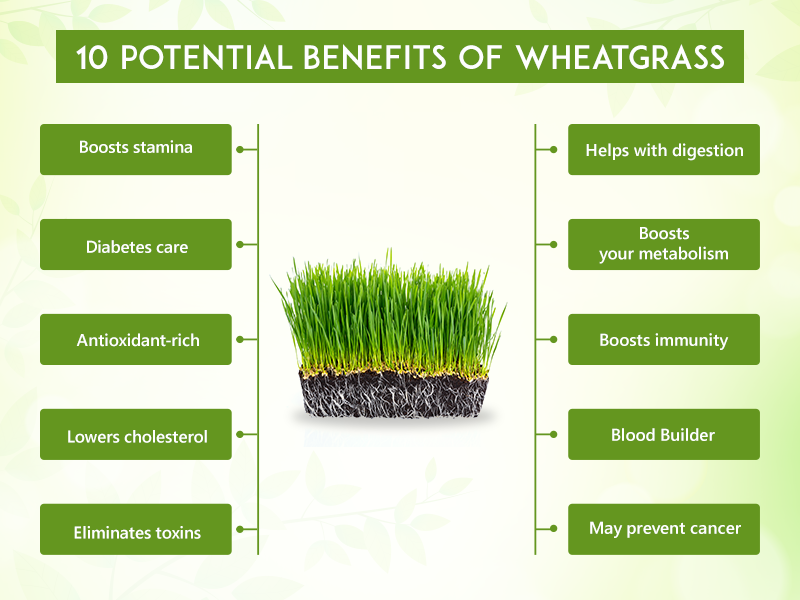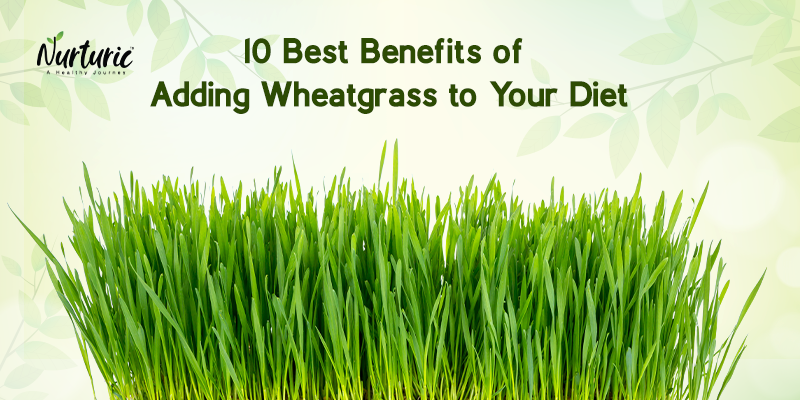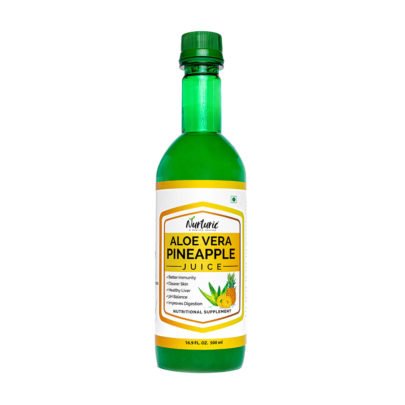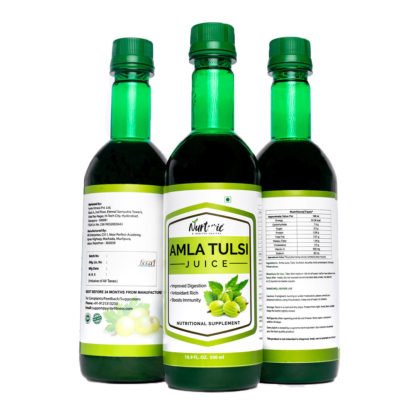- You have no items in your shopping cart
- Subtotal: ₹0.00
Given the proper nutrition, environment and exercise, the body has an inbuilt ability to heal itself. Most of our lifestyle-related disorders and ailments can be traced back to our sedentary lifestyle and poor eating habits. It is difficult to change many aspects of your lifestyle, but even small changes can make a big difference. Wheatgrass benefits were previously unknown to many, but they are now receiving much-deserved attention.
The new green grass of the wheat plant, known by the name of ‘Liquid Gold,’ is popular because of its nutritional value before seeds develop. It is known as ‘Green Blood’ as it is nutrient-rich and healthy, with high chlorophyll content. So, what is wheatgrass? Let’s find out!
Wheatgrass – More Than Just a Grass
Wheatgrass is a unique life-sustaining food or Triticum Aestivum high in chlorophyll and other vitamins and minerals. First, agricultural chemist Charles Schnabel discovered the healing properties of wheatgrass. Wheatgrass has been treasured for its medicinal properties for over 5000 years, and it contains 98 soil elements. Among these essential elements are phosphorus, calcium, iron, magnesium and potassium. In addition, the vitamins A and C of wheatgrass are more than those of carrots and oranges.
Now that we’ve seen what wheatgrass is, let’s take a look at the 10 reasons to add wheatgrass to your daily diet and reap all the benefits.
10 Reasons to Add Wheatgrass to Your Daily Diet
Wheatgrass is a beautiful plant. Everyone knows it’s good for health, but do you know what nutrients you get from it? Wheatgrass is a type of grass that has been used for therapeutic and healing purposes for over 5000 years. Wheatgrass, like most plants, benefits your health by supplying over 100 nutrients, chlorophyll, amino acids, minerals, vitamins and enzymes.
Wheatgrass is a potent antioxidant and anti-inflammatory in nature that can help detox, boost your immune system and keep you healthy. Let us see if wheatgrass really has any health benefits. We’ll also go over potential side effects and risks and the best way to incorporate them into your diet.
Boosts Stamina
Wheatgrass is a superfood with numerous health benefits. It is highly rich in chlorophyll and antioxidants. Minerals such as magnesium and calcium, and multiple vitamins in wheatgrass can supply red blood cells to the entire body, which oxygenates every cell. As a result, the body gives you a boost of stamina.
Diabetes Care
Wheatgrass has been proven to improve the function of the pancreas in producing insulin and increasing enzymes that lower blood sugar levels, reducing the risk of diabetes. In addition, wheatgrass improves lipids and glucose levels and can help you control your rising blood-glucose levels while also enhancing triglycerides, a blood fat.
Antioxidant-Rich
Antioxidants are compounds that fight free radicals produced by normal cell metabolism produced by external sources such as pollution and medication. Unfortunately, too many free radicals in our body can accumulate and cause oxidative stress, which could be the root cause of various health issues, including heart disease, autoimmune disorders and neurodegenerative diseases. Wheatgrass contains antioxidants that help reverse the effects of free radicals in your body, maintain your skin’s vitality and combat arthritis.
Lowers Cholesterol
The Human body requires cholesterol to produce bile, which is necessary for digestion and hormones, which control most essential functions such as hunger, mood and reproduction. Wheatgrass may positively affect cholesterol levels by lowering total cholesterol, LDL (bad cholesterol) and triglycerides, increasing your risk of heart disease.
Eliminates Toxins
Wheatgrass is beneficial to your liver. It is highly alkaline and nutrient-dense, making it an ideal detox tool. In addition, it contains compounds that aid detoxification, such as enzymes and other nutrients, and it may help restore and even protect the liver.
Helps with Digestion
Instead of taking antacids to treat heartburn or indigestion, wheatgrass is the best remedy to treat digestive disorders and detoxify the gastrointestinal tract. Wheatgrass contains several elements, including vitamins, amino acids and fibre, that can contribute to digestion and help the functioning of the muscles of the digestive system, help reduce stomach irritation and other bowel infections.
Boosts your Metabolism
Your immune system is a natural protection system for your body against infections from minor diseases such as cold to severe illnesses. The robust immune system allows free radicals and disease-causing toxins to be combated. Wheatgrass can help fight infections that are particularly antibiotic-resistant or in people who are allergic to certain antibiotics.
Wheatgrass benefits the immune system and fights oxidative stress.
Boosts Immunity
Wheatgrass is packed with essential amino acids and enzymes that protect your body from carcinogenic effects and the harmful effects of toxins that can damage your body. The impressive nutrients in wheatgrass strengthen every single cell in your body. Wheatgrass boosts the body’s immunity by increasing the number of red blood cells, which aids in the prevention of common diseases such as grippe, cough, cold and other infections.
Blood Builder
Chlorophyll is an active constituent of wheatgrass, which is a crucial blood builder.
The chlorophyll molecules are very similar to the hemin molecules, which combine with protein to form haemoglobin. As a result, wheatgrass can increase the oxygen content in the blood, making it an excellent circulatory stimulant.
Prevents Cancer
Wheatgrass is effective in cancer treatment due to vitamin E and an aspect known as Selenium, which is well-known for its antioxidant properties, which help prevent cell damage.
Cancer cannot thrive in an oxygen-rich environment, and wheatgrass can increase oxygen supply and neutralise the effects of carcinogenic elements beneficial to health.
Now that you’ve seen what wheatgrass can do to our body, let’s look at who needs it and how it can treat or cure illness.
Who Needs It – Which Conditions Can It Treat or Prevent?
A wheatgrass shot is similar to taking a superfood vitamin. The nutritional value and benefits are extremely concentrated and far-reaching, almost like a body reset. Wheatgrass is a nutrient-dense power plant that outperforms full-grown vegetables in digestion, skin health, blood and heart health.
Let’s take a look at who wheatgrass can help.
- It is helpful for those who want to boost their immunity
- Those suffering from anaemia
- Diabetes patients
- Concerning joint issues
- Digestive problems
- Skin problems
- Those suffering from high blood pressure
- People who have low stamina

Now that we have seen the uses of wheatgrass and what precautions must be taken, let’s look at the positive side effects of wheatgrass.
Possible Side Effects
While wheatgrass can cause nausea, loss of appetite or constipation in some individuals, pregnant women and breastfeeding mothers should refrain from consuming it unless advised otherwise by their practitioner. Excessive consumption of wheatgrass juice in a short time causes indigestion as the body cannot digest it properly. In the first few days after the wheatgrass juice is consumed, moderate fever may occur as the purifying process begins due to sudden chemical changes in the bloodstream. Wheatgrass is a gluten-free leafy shrub, and it can be contaminated with gluten during the harvesting or processing of wheatgrass juice.
Excessive consumption of wheatgrass juice in a short time causes indigestion as the body cannot digest it properly. In the first few days after the wheatgrass juice is consumed, moderate fever may occur as the purifying process begins due to sudden chemical changes in the bloodstream. Wheatgrass is a gluten-free leafy shrub, and it can be contaminated with gluten during the harvesting or processing of wheatgrass juice.
While organic wheatgrass benefits are considered reasonably safe, do these supplements contain risks or side effects? Let us investigate.
Does It Work – What Do Studies Suggest?
Wheatgrass has recently been discovered in India, although it has been known in the West for many years. Wheatgrass will give you more energy by filling nutritional gaps and detoxifying the body. Wheatgrass juice contains chlorophyll, which neutralises infections, heals wounds, reduces inflammation and eliminates parasitic infections. The three significant wheatgrass effects on the human body are blood purification, detoxifying the liver and cleansing the liver.
Initially, the majority of the subjects were found to be moderately anaemic. After one month of intervention with wheatgrass juice, the test group’s haemoglobin level increased by an average of 3g/dl, while the control group showed no change. According to the research results, the juice also acted as a laxative, relieving constipation in many subjects.
Now that we have seen what studies suggest about wheatgrass let us see how wheatgrass can contribute to your health.
Nutritional Information and Ingredients – Background
Wheatgrass has thousands of significant benefits, but here’s a quick rundown of the wheatgrass nutrition facts to show you just how good this superfood truly is.
The nutritional equivalent of 30ml of freshly squeezed wheatgrass is 1kg of leafy green vegetables, where a teaspoon of Wheatgrass powder has the same nutritional value as 50g spinach. Two fluid ounces of concentrated wheatgrass juice contain 15 calories, 15% of your daily vitamin C dose, and 20% of your daily iron dose. It also has vitamin E, calcium, and magnesium in it. Now that you know about the Wheatgrass nutrients, benefits and potential side effects of Wheatgrass, let’s discuss how to choose the best way to incorporate it to make the most of it.
Two fluid ounces of concentrated wheatgrass juice contain 15 calories, 15% of your daily vitamin C dose, and 20% of your daily iron dose. It also has vitamin E, calcium, and magnesium in it. Now that you know about the Wheatgrass nutrients, benefits and potential side effects of Wheatgrass, let’s discuss how to choose the best way to incorporate it to make the most of it.
How to Choose the Right Supplement. Where to Buy It From
Wheatgrass is a green food with a wide range of potential health benefits and no known side effects. When fresh wheatgrass is available, it is always the best option. However, if you want to buy, you must first check the following. Are their products organic or safe? Check that the company or manufacturer is legitimate and credible, especially for green superfoods like wheatgrass powder. Wheatgrass powder supplements are also available. When the grass is grown, processed and stored in specific conditions, the powder is supposed to retain all of the beneficial enzymes, vitamins and minerals found in fresh wheatgrass. Many customers are very particular about the ingredients in this powder. If you have allergies such as gluten sensitivity or lactose intolerance, you should be safer when purchasing products that can cause allergies and diseases.
Wheatgrass powder supplements are also available. When the grass is grown, processed and stored in specific conditions, the powder is supposed to retain all of the beneficial enzymes, vitamins and minerals found in fresh wheatgrass. Many customers are very particular about the ingredients in this powder. If you have allergies such as gluten sensitivity or lactose intolerance, you should be safer when purchasing products that can cause allergies and diseases.
Many companies sell these extracts. If you are looking for organic, you can buy Nurturic Wheatgrass Powder, which is 100% organic extract.
Final Words:
This is a natural supplement that has a myriad of health benefits. However, the nutritional value of wheatgrass gives you a compelling reason to incorporate it into your daily diet. Consuming it as part of a well-balanced diet in limited quantities can provide various health benefits while also meeting your daily nutritional requirements.
FAQ’s
1. What happens when you drink wheatgrass every day?
On regular consumption, you can benefit from high levels of digestive enzymes such as protease and lipase, which aid in protein digestion, fat splitting and protecting against oxidative stress.
2. How much wheatgrass should you drink a day?
Wheatgrass has a high level of potency. So add 1-2 teaspoons of wheatgrass powder into 250 ml of water, stir well and drink it every day to stay healthy.
3. When should I take wheatgrass?
It is recommended to take it first in the morning with an empty stomach to reap its benefits.
4. How long does it take for wheatgrass to work?
Wheatgrass is considered safe when taken orally for 18 months. You can feel the energy-boosting benefits of drinking a glass of wheatgrass juice within just an hour.
5. What is the best way to consume wheatgrass?
Wheatgrass is known to have a strong taste. The simplest way to consume wheatgrass is to juice it with fruits of your choice or mix it with honey.
6. What are the benefits of drinking wheatgrass?
Wheatgrass has grown in popularity over the years due to claims that it can lower blood sugar levels, give skin a radiant glow, and aid in weight loss.
7. Does wheatgrass affect periods?
No, it eases menstrual cramps and regulates the menstrual cycle on regular consumption of wheatgrass as it is packed with vitamins and minerals.
8. Is wheatgrass good for skin?
Yes. Wheatgrass detoxifies the body and improves the skin’s natural radiance. When consumed daily, wheatgrass can cure acne-prone skin, remove blemishes and reduce pigmentation.
9. Does wheatgrass increase haemoglobin?
Yes. Wheatgrass contains high amounts of chlorophyll, which stimulates and accelerates the growth of red blood cells, increasing haemoglobin levels.
10. Does wheatgrass help balance hormones?
Yes. Wheatgrass helps in hormone balance through liver detoxification, and three of its primary constituent nutrients, chlorophyll, vitamin B12, and folic acid, aid in hormonal regulation.











